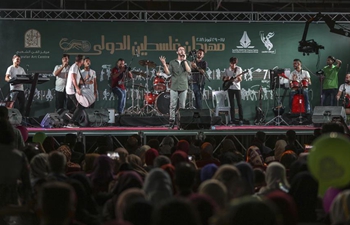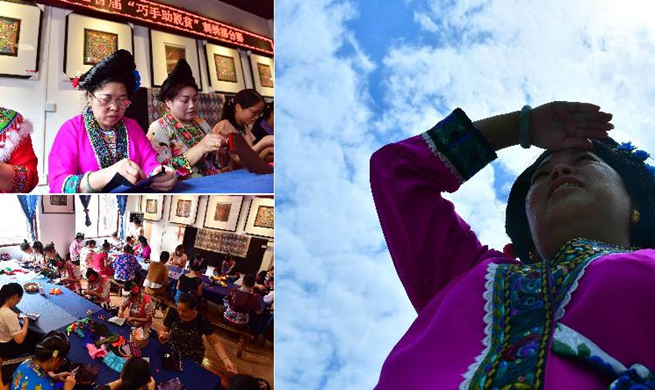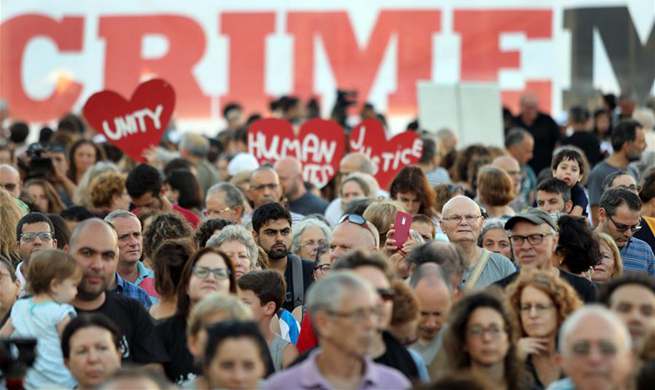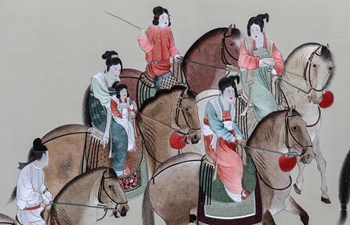FUZHOU, July 31 (Xinhua) -- Lin Leju, a villager of Datian County, South China's Fujian Province, took three photos of a Buddha statue worshiped in the village temple in 1989.
Twenty-nine years later, these photos became evidence in court to prove the statue held by a Dutch collector was the one stolen from the village.
Villagers of Yangchun demanded the Dutch collector return the Buddha at a court session held in the Intermediate People's Court of Sanming on July 26.
The statue contains the mummified body of Zhang Gong, a local man who became a monk in his 20s and won fame for helping people treat disease and spreading Buddhist beliefs.
When he died at the age of 37, his body was mummified and placed inside the statue during China's Song Dynasty (960-1279). The statue has been worshipped in the village temple Pu Zhao Tang with ancestors of Lin's family for over 1,000 years.
The photos were taken during the birthday celebration of the Buddha in 1989. On the early morning of December 15 of 1995, it was found stolen.
Lin and his fellow villagers reported the incident to local police and looked for the missing statue in almost every temple and antique market in nearby counties, but their labor was in vain.
Three years later, the fatigued and disappointed villagers remade a Zhang Gong statue using camphor wood based on their memory of the missing Buddha. But they never gave up hope of its recovery.
Their hope was rekindled by an exhibition at the Hungarian Natural History Museum in March 2015.
Lin Wenqing was in southwest China's Guangxi when he saw an online article about a mummified body of a Buddha on display in Budapest on the night of March 16.
Staring at the news photos featuring a statue familiar to him, he immediately thought of Lin Leju.
"Lin Leju had taken photos of the Buddha, so I phoned him right away," said Lin Wenqing. "He told me several villagers had decided to act and asked me to come back to help."
He took a morning flight the next day and met with several villagers to compare the pictures.
"The middle-aged and the elderly gathered at the village temple and studied the pictures. They assured us it was the same statue."
In the following weeks, they collected the Buddha's cap and gown, which were left behind by burglars, and village records with references to Zhang Gong as evidence, and showed them to journalists who flocked into the remote mountain village from all over the world.
Some 300 villagers even signed a petition to Dutch Prime Minister Mark Rutte, who was on a visit to China in April, seeking help from the Dutch government for the Buddha's return.
Meanwhile, they also contacted overseas Chinese in the Netherlands to make contact with the collector, whose identity was revealed in May as Oscar van Overeem, a Dutch architect.
The collector said he would return the Buddha to the village, but the villagers' excitement didn't last long as they saw a shift of attitude months later.
Negotiations failed. By the end of 2015, villagers filed separate lawsuits against Van Overeem in both Chinese and Dutch courts.
Lin Wenqing gave up his tea and construction materials businesses in Guangxi in early 2016 and returned to Sanming city to be more involved in a village committee devoted to the matter.
For more than two years, committee members regularly traveled to major cities in China to meet lawyers and overseas contacts.
To save costs, three or four villagers would share a basement room, eat instant noodles and book red-eye flights for intercity trips.
The Dutch court registered the village's lawsuit in June 2016, and the first Amsterdam court public hearing was held in July 2017.
At the hearing, Van Overeem claimed to have swapped the Buddha with another buyer and refused to disclose the identity of the disputed new holder.
Years of arduous judicial processes have forced changes in the village.
"We used to greet each other by asking 'how are you doing?' or 'where are you going?' in the village," said Lin Wenqing, "but now they would ask 'how is the case going?' or 'when will the Zhang Gong statue come back?' whenever they met us."
The disputed case has attracted worldwide attention, which brought both Zhang Gong and the village more fame. Lin said thanks to the media exposure, many believers of Zhang Gong from home and abroad traced their origin to the village.
Over 10,000 people swarmed to the village to pay homage to Master Zhang Gong on his birthday last year, and the village had to expand the building in front of the temple and the parking lot to accommodate more believers, according to Lin.
The Intermediate People's Court of Sanming registered the case in 2015. The court session was finally opened after over two and a half years.
The focus of the court session Thursday is whether the stolen Buddha is the one acquired by van Overeem in 1996 in Amsterdam.
The next court session will be announced at a later date. Van Overeem's agents asked for a two-month extension to gather more evidence.
Villagers say they have complete trust in their legal team and will assist in collecting more evidence, but they do not see any alternative route for the cause.
"We are always grateful to Mr. Van Overeem for taking care of the Buddha, and we will try to make direct contact with him to build mutual trust," said Lin.
Lin Kai'an, who attended the hearing as village party chief, said every day, they pray for the return of the Zhang Gong as soon as possible.
With money raised by believers of Master Zhang Gong, the refurbishment of the village temple is underway to prepare for the return of the statue. It is expected to be completed in two months.
"The statue had been kept and worshipped in our village for generations, but it was stolen when in our care," said Lin Kai'an. "It is our duty to get it back, and we will spare no efforts."

















